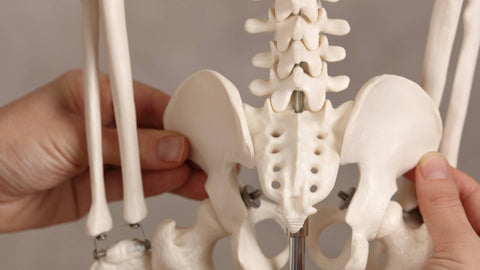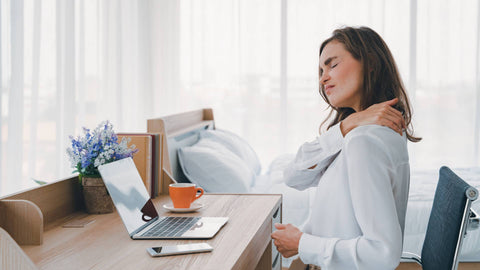Uneven hips can make getting a good night's sleep challenging. This common condition can lead to discomfort, pain, and poor posture if not addressed properly. Using a pillow between your knees while sleeping on your side can help align your spine and reduce pressure on your hips.
Sleep position plays a crucial role in managing uneven hips. Side sleeping with proper support can alleviate discomfort and promote better alignment. Placing a pillow between your knees helps maintain proper hip placement and prevents your pelvis from twisting during the night.
For those who prefer back sleeping, a small pillow or rolled towel placed under the lower back can provide additional support. This adjustment can help distribute your weight more evenly and reduce strain on your hips. Experimenting with different sleep positions and support methods can help you find the most comfortable arrangement for your unique needs.
Understanding Uneven Hips
Uneven hips can impact your posture, comfort, and overall body alignment. This condition occurs when one hip sits higher than the other, potentially affecting your spine and pelvis.
Causes of Hip Imbalance
Several factors can lead to uneven hips. Scoliosis, a sideways curvature of the spine, is a primary cause. Leg length discrepancy, where one leg is shorter than the other, can also result in hip misalignment. Injuries to the pelvis or hip joint may cause imbalance. Age-related changes and muscle imbalances can contribute to lateral pelvic tilt.
Genetics play a role too. Some people are born with slightly different leg lengths or hip structures. Poor posture habits and repetitive motions can exacerbate hip imbalances over time.
Common Symptoms
Uneven hips often lead to noticeable symptoms. You might experience lower back pain or discomfort in one or both hips. Walking may feel uneven, with a slight limp or imbalance in your gait.
Your clothes may fit differently on each side. One shoulder might appear higher than the other when standing straight. You may notice uneven wear on your shoes. Some people experience muscle tightness in the lower back, hips, or legs.
Conducting the Trendelenburg Test
The Trendelenburg test helps identify hip muscle weakness. To perform it:
- Stand in front of a mirror.
- Lift one foot off the ground, balancing on the other leg.
- Observe your pelvis in the mirror.
If your pelvis drops on the side of the raised leg, it indicates weakness in the hip abductor muscles on the standing leg. This is called a positive Trendelenburg sign. A strong, stable pelvis during the test suggests healthy hip muscles.
Repeat the test on both sides to compare. If you notice a difference, consult a healthcare professional for a thorough assessment.
Effective Sleeping Positions
Finding the right sleeping position is crucial for those with uneven hips. Proper alignment can reduce discomfort and improve sleep quality.
The Right Sleep Position for You
Side sleeping is often recommended for people with uneven hips. It allows for better spinal alignment and can relieve pressure on your hips. Place a pillow between your knees to keep your hips level.
Back sleeping is another good option. It distributes your weight evenly and can help maintain proper alignment. Use a thin pillow under your head to keep your spine neutral.
Avoid stomach sleeping if possible. This position can strain your lower back and exacerbate hip pain.
Adjustments for Side Sleepers
If you prefer side sleeping, use a firm pillow between your knees. This helps keep your hips, pelvis, and spine aligned. Choose a thicker pillow if you have wider hips.
Consider using a body pillow for additional support. It can help maintain proper alignment from your shoulders to your knees.
A memory foam mattress can provide extra comfort by contouring to your body shape. This reduces pressure points and supports your hips.
Tips for Back and Stomach Sleepers
For back sleepers, place a small pillow under your knees. This slight elevation can help maintain the natural curve of your spine and reduce pressure on your hips.
Use a supportive mattress to prevent your hips from sinking too deeply. A medium-firm mattress often works well for back sleepers.
If you must sleep on your stomach, put a thin pillow under your hips. This can help reduce the arch in your lower back and alleviate hip strain.
Regardless of your preferred position, ensure your mattress provides adequate support. Replace it if it's more than 7-10 years old or shows signs of sagging.
Exercises and Stretches for Alignment
Regular exercise and stretching can help correct uneven hips and improve alignment. These movements target key muscles and promote flexibility in the hips and lower back.
Hip Strengthening Exercises
Start with clamshells to activate your glute medius. Lie on your side with knees bent, keeping feet together. Lift your top knee while keeping feet touching. Hold for 2 seconds, then lower. Repeat 10-15 times per side.
Single-leg bridges strengthen your glutes and core. Lie on your back, knees bent. Lift one foot off the ground, then raise your hips. Hold for 2-3 seconds before lowering. Do 10-12 reps on each side.
Side-lying leg raises target your hip abductors. Lie on your side, lift your top leg about 45 degrees. Hold briefly, then lower. Perform 12-15 reps, then switch sides.
Fire hydrants work your outer hips. Start on hands and knees. Lift one leg out to the side, keeping your knee bent. Lower and repeat 12-15 times before switching legs.
Stretches for Hip and Spine
The seated figure-four stretch targets your piriformis muscle. Sit with one ankle on the opposite thigh. Gently lean forward until you feel a stretch. Hold for 30 seconds, then switch sides.
Try the standing quadratus lumborum stretch. Stand straight, raise one arm overhead. Lean to the opposite side until you feel a stretch along your side. Hold for 20-30 seconds, then switch.
The pigeon pose from yoga opens tight hips. Start in a plank, bring one knee forward towards your hand. Extend your back leg. Hold for 30-60 seconds, feeling the stretch in your hip flexors.
Perform the seated spinal twist to improve spine mobility. Sit with legs extended. Bend one knee, placing that foot outside the opposite thigh. Twist towards the bent knee. Hold for 20-30 seconds per side.
Professional Help and Lifestyle Adjustments
Addressing uneven hips often requires a combination of medical guidance and daily habit changes. Seeking professional help and making targeted lifestyle adjustments can significantly improve your comfort and alignment.
When to See a Doctor or Physiotherapist
If you experience persistent discomfort or notice a significant difference in hip height, consult a doctor or physiotherapist. They can assess your condition through physical examinations and imaging tests.
A physiotherapist may recommend specific exercises to strengthen weak muscles and stretch tight ones. These exercises aim to correct muscular imbalances contributing to your uneven hips.
Your doctor might suggest further treatments like chiropractic adjustments or orthotics if needed. They can also rule out underlying conditions causing hip misalignment.
Incorporating Lifestyle Changes
Improving your posture is crucial for managing uneven hips. Be mindful of your sitting position, especially if you have a sedentary job. Use ergonomic chairs and take regular breaks to stand and stretch.
Engage in activities that promote hip stability and flexibility, such as yoga or Pilates. These can help reduce tension and improve overall hip alignment.
Consider using a standing desk or alternating between sitting and standing throughout the day. This change can alleviate pressure on your hips and lower back.
Wear supportive shoes and avoid high heels, which can exacerbate hip imbalances. If recommended by a professional, use orthotic inserts to help level your hips.



